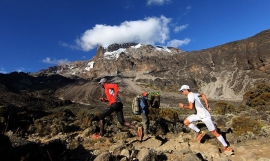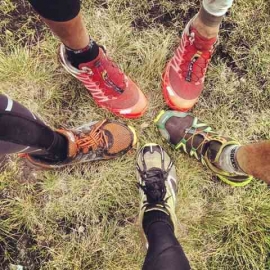John Bale的其他跑步书籍:
East African Running: Toward a Cross-Disciplinary Perspective_Yannis Pitsiladis;John Bale;Craig Sharp_2006
下载地址://www.nduoke.com/shujixiazai/0415377889-east-african-running-download
Running Cultures: Racing in Time and Space (Sport in the Global Society)_John Bale_2003
Kenyan Running: Movement Culture, Geography and Global Change 简介:
1997 British Society of Sports History - Lord Aberdare Literary Prize for Sports History
The record-breaking achievements of Kenyan athletes have caught the imagination of the world of sport. How significant really is Kenya in the world of sports? This book, the first to look in detail at the evolution and significance of a single sport in an African country, seeks to answer these and many other questions. Kenyan Running blends history, geography, sociology and anthropology in its quest to describe the emergence of Kenyan athletics from its pre-colonial traditions to its position in the modern world of globalized sport. The authors show the qualities of stamina and long distance running were recognized by early twentieth century travellers in east Africa and how modern running was imposed by colonial administrators and school teachers as a means of social control to replace the indigenous fold traditions.
Kenyan Running: Movement Culture, Geography and Global Change 读者评论:
How are we to explain the seemingly phenomenal success of East African athletes in the sport of track and field? One approach, advocated by Roger Bannister, former mile world record holder and currently a consultant neurologist, is to explain such success in biological terms. During 1996, in a series of speculative statements, not grounded in any `scientific' facts, Bannister highlighted the importance of `race' in determining thesuccess of East African athletes. On reading Kenyan Running, it is clear that, on this occasion, Bannister is firmly on the wrong track.
John Bale and Joe Sang have produced an excellent account of the emergence and development of Kenyan athletics. This carefully crafted text demonstrates, time and again, the socio - cultural determinants of sporting success. In offering a cogent, social scientifically based account, Bale and Sang provide a clear riposte to advocates of biological determinism. In particular, in chapter six, the environmental and racial myths associated with `Kenyan' success are carefully dissected. Besides, who are these `Kenyan' men who succeed in specific athletic events? This book provides the answers. The debunking of biological determinism is an important achievement in itself. This book, however, does more than this. It has several other virtues.
In Kenyan Running we see not only the theoretical advocacy, but also the empirical demonstration, of an approach to the study of sport that draws on geography, history and sociology. While I would have liked the authors to have been even more explicit in this regard, the book provides a very good example of the potential stemming from a blending of different disciplines. No doubt, advocates of these disciplines would have liked to have seen more of `their' knowledge base in the book, but what has been produced provides an important pointer to what inter - or multi - disciplinary research can achieve.
Bale and Sang also provide a detailed account of a century of Kenyan involvement in modern athletics and, in doing so, assess the role of tribal traditions, colonial heritage and `development' processes. In these areas they provide a solid account of the actual dynamics involved. Drawing on traditional geographical methods, but also in keeping with new geographical directions, the authors provide a series of astute historical geographical insights. They are not content, however, to explain the `success' of Kenyan athletics solely in terms of `internal' developments. The authors show how such processes have to be explained in terms of the globalization of sport.
This connection between Kenyan athletics and the global sport system is another virtue of this book. For them, the emergence of Kenyan athletics is bound up with the globalization of sport. Drawing on Wallerstein's World System theory, Bale and Sang interpret Kenyan athletics in terms of a process of `underdevelopment'. Far from western coaches and sporting aid assisting Kenyan athletics uniformily, these authors argue that aspects of the sport have been, wittingly or otherwise, `underdeveloped'. For example, and in very concrete terms, Kenyan field athletic performance has declined over time. In contrast, through a combination of `channelling', self selection and role modelling, some Kenyan men excel at middle and long distance racing. This very success, however, leads to a dependent form of development. The `natural' resources of Kenya are drawn away from the periphery to the core. In sporting terms, the core involves American colleges and the European Grand Prix circuit. Bale and Sang rightly point to the costs, as well as the well publicised `benefits', of these processes.
The debate regarding sport and globalization is complex. The Wallerstein model has been rightly criticised by Robertson and Featherstone in the mainstream literature. It is no surprise then that reservations can also expressed in the context of the study of sport. The role of cultural relations, civilizational exchanges and lived experiences do not occupy a central place in the model. To be fair, Bale and Sang are keen to address aspects of these issues. Perhaps, however, in their conclusion to a fine book, they should have shown how their approach fits in as part of the debate about sport and the global system more generally. In addition, it would have been helpful to have returned to the theme of debunking the myths and biological determinism that underpins much of the media reporting, coaching beliefs and sport science assumptions concerning Kenyan athletic success. These are, however, minor quibbles. This is a book that can rightfully claim to be both imaginative and path - breaking.
Joseph Maguire
更多跑步书籍见://www.nduoke.com/running-books
跑步书籍下载见://www.nduoke.com/shujixiazai
跑步书籍百科见://www.nduoke.com/shujibaike
跑步书籍下载地址合集://www.nduoke.com/shujixiazai/download
跑步书籍汇集大全附下载://www.nduoke.com/running-books/daquan




